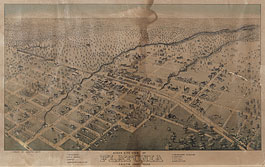Flatonia in 1881
The area around Flatonia was settled by Anglo-Americans prior to the Civil War, but inexpensive land gradually brought German, Bohemian, Greek, Arabian, and Italian immigrants into the region. The city itself was created by the Galveston, Harrisburg and San Antonio Railway as it built west through Fayette County from Schulenburg in April 1874. Residents of old Flatonia, one mile southeast of the new site, and Oso, three miles northeast… [More]
Fort Worth in 1876
Artist D. D. Morse arrived at a propitious moment in the history of Fort Worth. In April 1876, when he drew this classic bird’s-eye view from the northwest, the village, buffeted by the effects of the Civil War and economic depression, was struggling for its very existence. Established in 1849 as one of a series of military posts in the frontier defense system, the settlement had suffered the abandonment… [More]
Fort Worth in 1886
The arrival of the railroad ushered in an era of astonishing growth for Fort Worth as migrants from the devastated South continued to swell the population and small, community factories and mills yielded to larger businesses. Newly dubbed “Queen City of the Prairies,” Fort Worth supplied a regional market via the growing transportation network. More smokestacks are evident in Henry Wellge’s 1886 view, which the editor of the Fort… [More]
Fort Worth in 1891
The fact that Henry Wellge was back in Fort Worth in 1891 to revise his 1886 view demonstrates the concern the city fathers had in promoting the city, as they tried to recover from the difficult economic conditions. Again depicting the city from the northeast, Wellge showed the same basic area as in the 1886 print, suggesting that he might have used the earlier print as a pattern for… [More]
Gainesville in 1883
The Gainesville that Augustus Koch depicted in 1883 was a prosperous cattle town, with a large courthouse and public school building financed by income from the cattle business. The first Anglo-American settlers arrived in the area, on the western border of the Eastern Cross Timbers, where “the magnificent roll of the prairie is broken abruptly off against the woody rim,” in the 1840s, and the city was founded as… [More]















